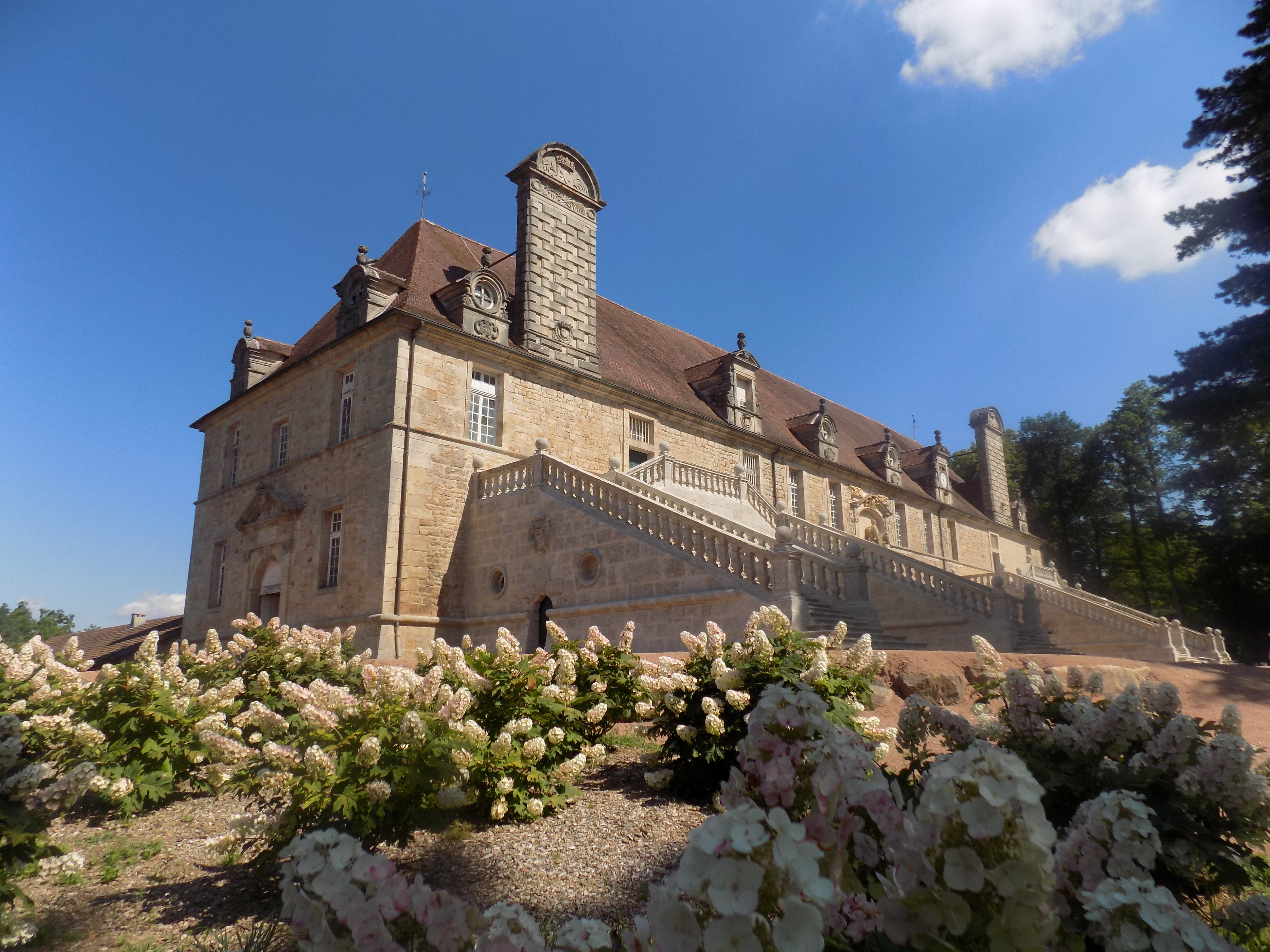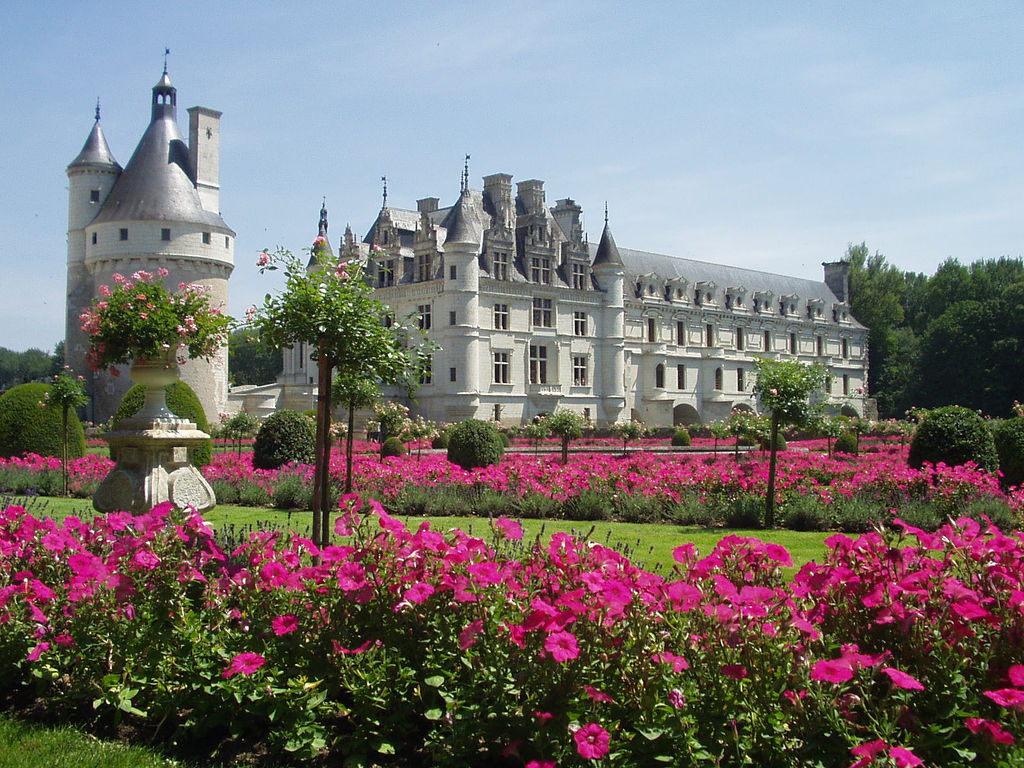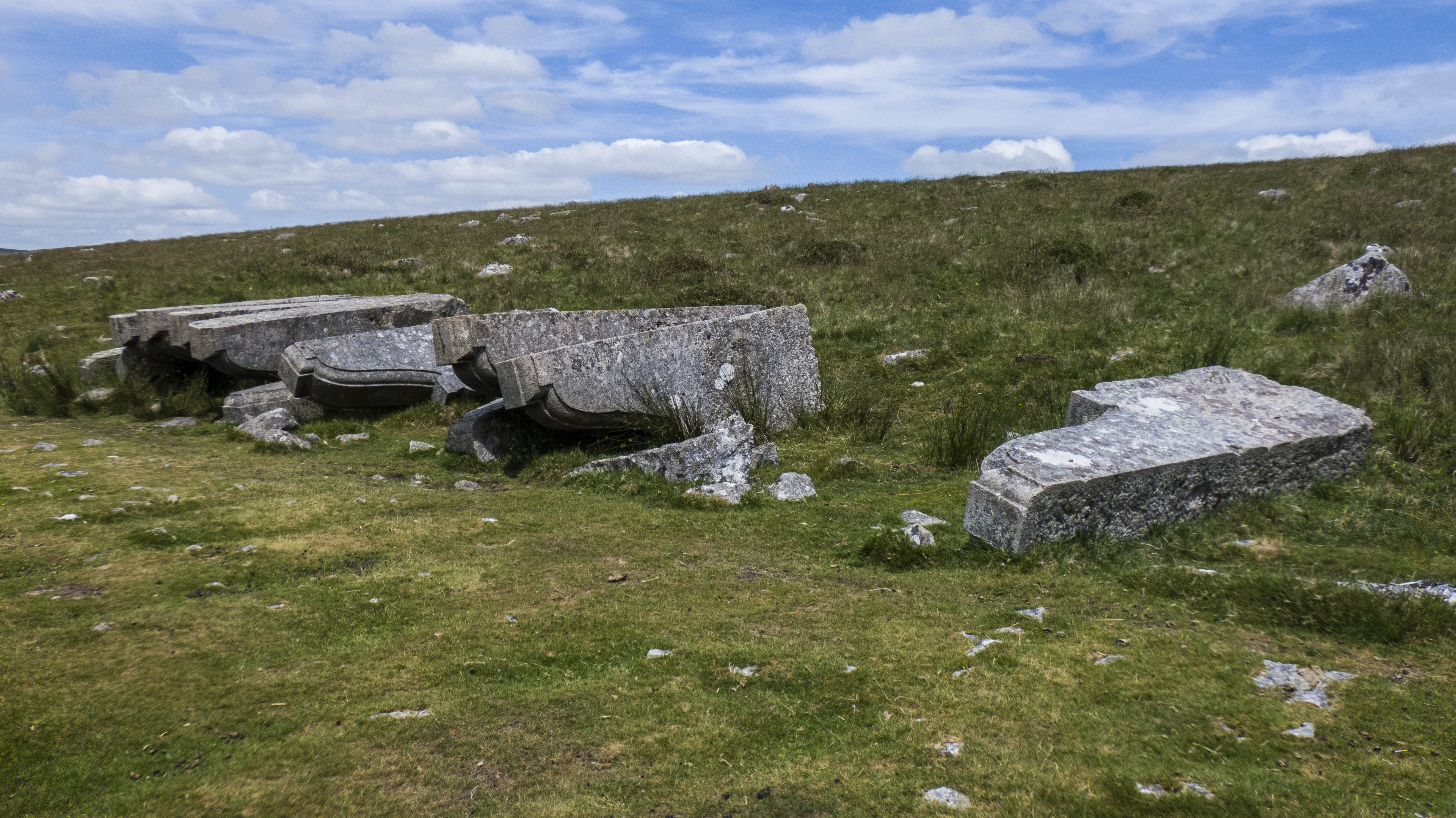|
Château De Chaumont-la-Guiche
The French Château de Chaumont-la-Guiche r -Laguiche(), located in Saint-Bonnet-de-Joux (Saône-et-Loire), in a region formerly known as Charolais in southern Burgundy Burgundy ( ; ; Burgundian: ''Bregogne'') is a historical territory and former administrative region and province of east-central France. The province was once home to the Dukes of Burgundy from the early 11th until the late 15th century. ..., was constructed beginning in 1500 for the .Babelon 1989, pp. 797–798. The most famous feature of the château is the monumental 17th-century stable block, designed by the noted French architect, François Blondel. Description The northwest façade of the ''corps de logis'' has tall mullion and transom (architectural), transom windows. An openwork stone balustrade runs along the base of the steeply pitched roof, which is pierced with dormers opening into the attic. At the right end is a large square pavilion, which rises an additional storey; toward the lef ... [...More Info...] [...Related Items...] OR: [Wikipedia] [Google] [Baidu] |
Château De Chaumont
The Château de Chaumont (), officially Château de Chaumont-sur-Loire, is a castle (''château'') in Chaumont-sur-Loire, Centre-Val de Loire, France. The castle was founded in the 10th century by Odo I, Count of Blois. After Pierre d'Amboise rebelled against Louis XI, the king ordered the castle's destruction. Later in the 15th century Château de Chaumont was rebuilt by Charles I d'Amboise. Protected as a ''monument historique'' since 1840, the château was given into state ownership in 1938 and is now open to the public. History The name ''Chaumont'' derives from the French ''chauve mont'', meaning "bald hill". The first castle on this site, situated between Blois and Amboise, was built by Odo I, Count of Blois, in the 10th century, with the purpose of protecting his lands from attacks by his feudal rival, Fulk Nerra, Count of Anjou. On his behalf the Norman Gelduin received it, improved it and held it as his own. His great-niece Denise de Fougère, ... [...More Info...] [...Related Items...] OR: [Wikipedia] [Google] [Baidu] |
Attic
An attic (sometimes referred to as a '' loft'') is a space found directly below the pitched roof of a house or other building. It is also known as a ''sky parlor'' or a garret. Because they fill the space between the ceiling of a building's top floor and its slanted roof, attics are known for being awkwardly-shaped spaces with difficult-to-reach corners and often exposed rafters. While some attics are converted into bedrooms, home offices, or attic apartments complete with windows and staircases, most remain difficult to access, and are usually entered using a loft hatch and ladder. Attics help control temperatures in a house by providing a large mass of slowly moving air, and are often used for storage. The hot air rising from the lower floors of a building is often retained in attics, further compounding their reputation as inhospitable environments. However, in recent years, they have been insulated to help decrease heating costs, since, on average, uninsulated attics ac ... [...More Info...] [...Related Items...] OR: [Wikipedia] [Google] [Baidu] |
Émile Sagot
Émile Sagot (1805–1888) was a French illustrator and lithographer. Plan général du Château de Tanlay, Bourgogne. Des. par E. Sagot et Lahorey - btv1b84432476 (2 of 3).jpg, Château de Tanlay Château de Chaumont, Saône-et-Loire.jpg, Château de Chaumont-la-Guiche Église saint Gengoux-le-National.jpg, Saint-Gengoux-le-National Saint-Gengoux-le-National () is a commune in the Saône-et-Loire department in the region of Bourgogne-Franche-Comté in eastern France. It was formerly known as Saint-Gengoux-le-Royal. History In the 10th century, the church of Saint-Gengoux ... References External links French illustrators French lithographers 1805 births 1888 deaths {{France-artist-stub ... [...More Info...] [...Related Items...] OR: [Wikipedia] [Google] [Baidu] |
Neo-Gothic
Gothic Revival (also referred to as Victorian Gothic or neo-Gothic) is an architectural movement that after a gradual build-up beginning in the second half of the 17th century became a widespread movement in the first half of the 19th century, mostly in England. Increasingly serious and learned admirers sought to revive medieval Gothic architecture, intending to complement or even supersede the neoclassical styles prevalent at the time. Gothic Revival draws upon features of medieval examples, including decorative patterns, finials, lancet windows, and hood moulds. By the middle of the 19th century, Gothic Revival had become the pre-eminent architectural style in the Western world, only to begin to fall out of fashion in the 1880s and early 1890s. For some in England, the Gothic Revival movement had roots that were intertwined with philosophical movements associated with Catholicism and a re-awakening of high church or Anglo-Catholic belief concerned by the growth of religi ... [...More Info...] [...Related Items...] OR: [Wikipedia] [Google] [Baidu] |
Lyonnais
The Lyonnais (, ) is a historical province of France which owes its name to the city of Lyon. The geographical area known as the ''Lyonnais'' became part of the Kingdom of Burgundy after the division of the Carolingian Empire. The disintegration of Imperial control, especially after the fall of the Hohenstaufens in 1254, led to French encroachment and eventual acquisition by King Philip IV of France in 1313. Lyonnais now often simply refers to the area around the city of Lyon Lyon (Franco-Provençal: ''Liyon'') is a city in France. It is located at the confluence of the rivers Rhône and Saône, to the northwest of the French Alps, southeast of Paris, north of Marseille, southwest of Geneva, Switzerland, north .... The local speech-form known as ''Lyonnais'' is a dialect of the Francoprovençal language that is spoken in the region, but its use is marginal. References External links * Former provinces of France {{RhoneAlpes-geo-stub ... [...More Info...] [...Related Items...] OR: [Wikipedia] [Google] [Baidu] |
Châteaux Of The Loire Valley
The châteaux of the Loire Valley () are part of the architectural heritage of the historic towns of Amboise, Angers, Blois, Chinon, Montsoreau, Orléans, Saumur, and Tours along the river Loire in France. They illustrate Renaissance ideals of design in France. The châteaux of the Loire Valley number over three hundred, ranging from practical fortification, fortified castles from the 10th century to splendid residences built half a millennium later. When the French kings began constructing their huge châteaux in the Loire Valley, the nobility, drawn to the seat of power, followed suit, attracting the finest architects and landscape designers. The châteaux and their surrounding gardens are cultural monuments which embody the ideals of the Renaissance and The Enlightenment, Enlightenment. Many of the châteaux were built on hilltops, such as the Château d'Amboise, while the only one built in the riverbed is the Château de Montsoreau. Many had exquisite churches on the grounds or ... [...More Info...] [...Related Items...] OR: [Wikipedia] [Google] [Baidu] |
House Of Amboise
The House of Amboise was one of the oldest families of the French nobility whose followed filiation dated back to the early twelfth century. It took its name from the town of Amboise in Touraine. The house of Amboise formed the two branches of Thouars (extinct in 1469 in the house of La Trémoille) and Chaumont (extinct in 1525) that gave the branches of Bussy (extinct in 1515) and Aubijoux (extinct in 1656). Cardinal Georges d'Amboise (1460–1510) was the son of Pierre d'Amboise, Seigneur de Chaumont. History Origins First house of Amboise (circa 1100-extinct in 1255) The first house of Amboise was founded in the eleventh century by Lisois, who was appointed as captain of the castle of Amboise by Foulk III Nerra, Count of Anjou. Geoffrey II, Count of Anjou gave to Lisois some Lands in Amboise to reward him. Lisois became lord of Amboise and died about 1061. His grandson Hugues I of Amboise came to power in 1107. He is most known for his seizure of Montrichard Castle ... [...More Info...] [...Related Items...] OR: [Wikipedia] [Google] [Baidu] |
Château De Chaumont-sur-Loire
A château (, ; plural: châteaux) is a manor house, or palace, or residence of the lord of the manor, or a fine country house of nobility or gentry, with or without fortifications, originally, and still most frequently, in French-speaking regions. Nowadays, a ''château'' may be any stately residence built in a French style; the term is additionally often used for a winegrower's estate, especially in the Bordeaux wine regions, Bordeaux region of France. Definition The word château is a French word that has entered the English language, where its meaning is more specific than it is in French. The French word ''château'' denotes buildings as diverse as a medieval fortress, a Renaissance palace and a fine 19th-century country house. Care should therefore be taken when translating the French word ''château'' into English, noting the nature of the building in question. Most French châteaux are "palaces" or fine "English country house, country houses" rather than "castles", an ... [...More Info...] [...Related Items...] OR: [Wikipedia] [Google] [Baidu] |
Jacques D'Amboise (bishop)
Jacques d'Amboise (between 1440 and 1450 – 27 December 1516) was a French religious dignitary and patron of medieval France. He was abbot of Jumièges then of Cluny, and bishop of Clermont. He was a member of the House of Amboise, an old noble family. Life He was the son of Anne de Bueil and Pierre d'Amboise, lord of Chaumont, as their seventh of eighteen children. Entering the Benedictine order he was elected abbot of Jumièges in January 1474, replacing his brother Louis on his appointment as bishop of Albi. Jacques took his oath of loyalty as abbot on 20 February 1474 and took possession of the abbey on 28 May. In 1485 he succeeded a Bourbon as abbot of Cluny, rebuilding the Cluny abbots' hôtel in Paris as well as its now-lost chapel and collège. Located beside the Gallo-Roman ruins, the hôtel de Cluny hosted several royal visits and would be inhabited by cardinal Mazarin in 1634. He also built the abbatial palace of Paray-le-Monial. The bishopric of Clermont had b ... [...More Info...] [...Related Items...] OR: [Wikipedia] [Google] [Baidu] |
Louis XII Of France
Louis XII (27 June 14621 January 1515), also known as Louis of Orléans was King of France from 1498 to 1515 and King of Naples (as Louis III) from 1501 to 1504. The son of Charles, Duke of Orléans, and Marie of Cleves, he succeeded his second cousin once removed and brother-in-law, Charles VIII, who died childless in 1498. Louis was the second cousin of King Louis XI, who compelled him to marry the latter's disabled and supposedly sterile daughter Joan. By doing so, Louis XI hoped to extinguish the Orléans cadet branch of the House of Valois. When Louis XII became king in 1498, he had his marriage with Joan annulled by Pope Alexander VI and instead married Anne, Duchess of Brittany, the widow of Charles VIII. This marriage allowed Louis to reinforce the personal Union of Brittany and France. Louis of Orléans was one of the great feudal lords who opposed the French monarchy in the conflict known as the Mad War. At the royal victory in the Battle of Saint-Aubin-du-Cormi ... [...More Info...] [...Related Items...] OR: [Wikipedia] [Google] [Baidu] |
Château
A château (, ; plural: châteaux) is a manor house, or palace, or residence of the lord of the manor, or a fine country house of nobility or gentry, with or without fortifications, originally, and still most frequently, in French-speaking regions. Nowadays, a ''château'' may be any stately residence built in a French style; the term is additionally often used for a winegrower's estate, especially in the Bordeaux region of France. Definition The word château is a French word that has entered the English language, where its meaning is more specific than it is in French. The French word ''château'' denotes buildings as diverse as a medieval fortress, a Renaissance palace and a fine 19th-century country house. Care should therefore be taken when translating the French word ''château'' into English, noting the nature of the building in question. Most French châteaux are "palaces" or fine " country houses" rather than "castles", and for these, the word "château" is appropr ... [...More Info...] [...Related Items...] OR: [Wikipedia] [Google] [Baidu] |
Corbels
In architecture, a corbel is a structural piece of stone, wood or metal keyed into and projecting from a wall to carry a bearing weight, a type of bracket. A corbel is a solid piece of material in the wall, whereas a console is a piece applied to the structure. A piece of timber projecting in the same way was called a "tassel" or a "bragger" in England. The technique of corbelling, where rows of corbels deeply keyed inside a wall support a projecting wall or parapet, has been used since Neolithic (New Stone Age) times. It is common in medieval architecture and in the Scottish baronial style as well as in the vocabulary of classical architecture, such as the modillions of a Corinthian cornice. The corbel arch and corbel vault use the technique systematically to make openings in walls and to form ceilings. These are found in the early architecture of most cultures, from Eurasia to Pre-Columbian architecture. A console is more specifically an S-shaped scroll bracket in the cl ... [...More Info...] [...Related Items...] OR: [Wikipedia] [Google] [Baidu] |








